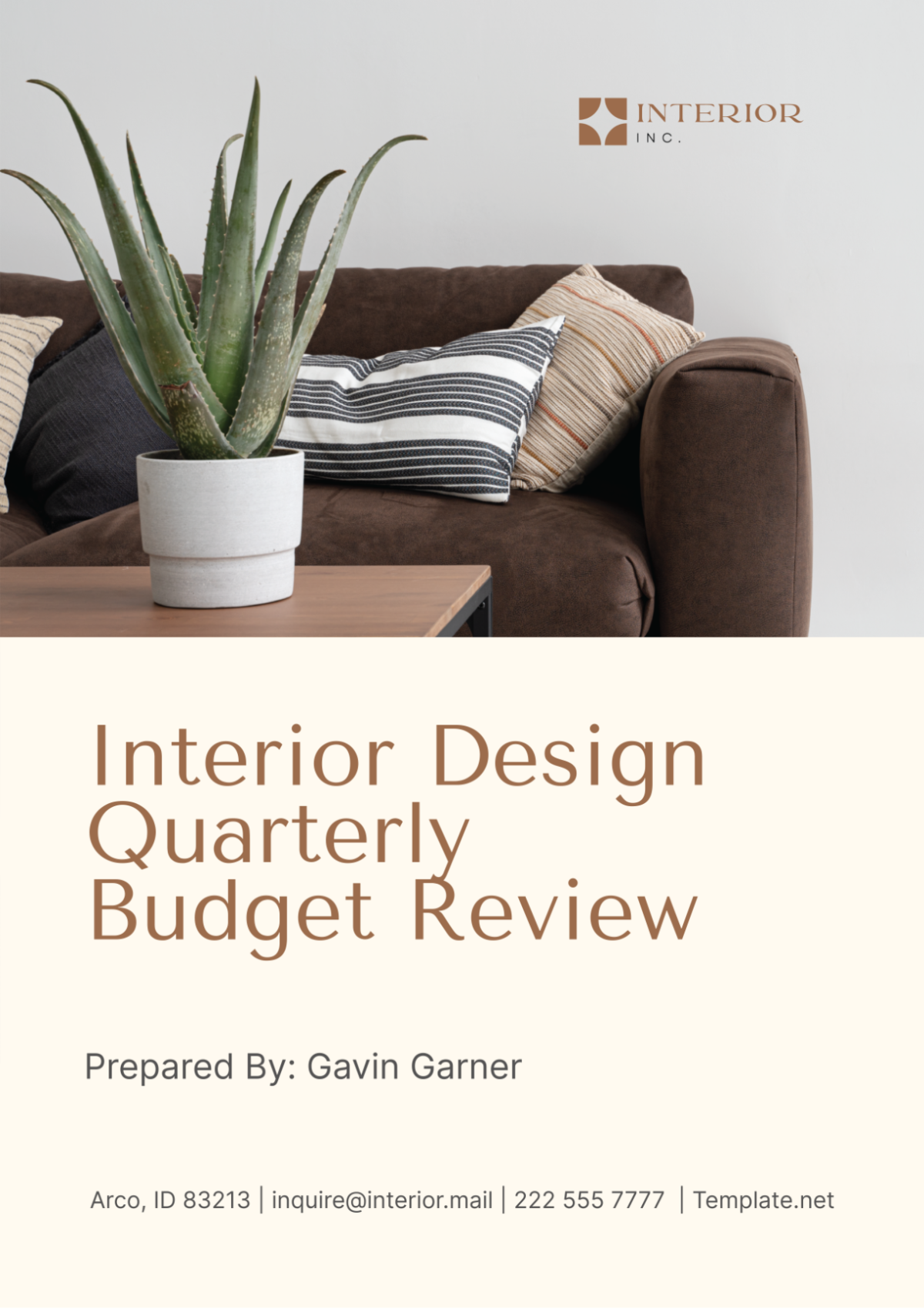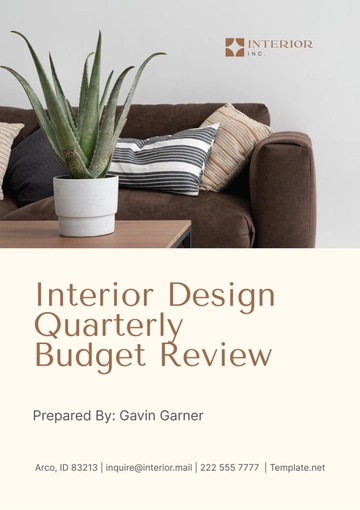Free Interior Design Quarterly Budget Review

1. Executive Summary
Welcome to the Quarterly Budget Review for [Your Company Name]. This document provides a comprehensive analysis of our financial performance over the past quarter and outlines the key financial highlights, areas of concern, and strategic recommendations moving forward.
During the quarter, we have experienced a stable financial period with a slight increase in revenue compared to the previous quarter. However, expenses have also risen, primarily due to unexpected costs in materials and outsourced labor. This review aims to delve into the details of these changes, assess the budget's effectiveness, and recommend adjustments to enhance our financial health and project delivery efficiency.
Key highlights of this quarter include:
A 5% increase in total revenue, driven by the completion of several high-profile projects.
An 8% increase in total expenses, attributed mainly to rising costs in premium materials.
Successful acquisition of two new corporate clients, which are expected to increase future revenue streams.
This summary provides an overview of the detailed analysis contained in the subsequent sections of this report.
2. Budget Overview
A. Total Budget for the Quarter
The total budget allocated for this quarter was $1.2 million, distributed across various departments and projects. Below is a table that outlines the planned versus actual spending:
Category | Planned Budget | Actual Spending | Variance |
|---|---|---|---|
Labor | $300,000 | $320,000 | $20,000 Over |
Materials | $400,000 | $450,000 | $50,000 Over |
Outsourcing | $100,000 | $150,000 | $50,000 Over |
Marketing | $50,000 | $45,000 | $5,000 Under |
Administrative | $150,000 | $140,000 | $10,000 Under |
Miscellaneous | $200,000 | $195,000 | $5,000 Under |
Total | $1,200,000 | $1,300,000 | $100,000 Over |
Analysis:
The above table illustrates a total overspending of $100,000, primarily due to unexpected rises in labor and material costs. This variance points to a need for tighter budget control and renegotiation of supplier contracts where feasible.
3. Revenue Analysis
A. Total Revenue Generated
This quarter, [Your Company Name] generated a total revenue of $1.35 million, marking a 5% increase from the previous quarter. The revenue sources were varied, with the largest contributions coming from commercial design projects and consultancy fees.
B. Revenue by Major Projects
The following table breaks down the revenue by major projects:
Project Name | Revenue |
|---|---|
Corporate Office Redesign | $500,000 |
Retail Space Layout | $300,000 |
Residential Housing Complex | $200,000 |
Consultancy Services | $350,000 |
Total | $1,350,000 |
C. Revenue Trends
The trend in revenue shows a healthy increase, particularly from consultancy services, which have grown due to our strengthened reputation in sustainable design solutions. This segment is projected to continue growing, which could be strategically beneficial.
4. Expenditure Analysis
A. Total Expenses
This quarter's total expenditure amounted to $1.3 million. A detailed analysis reveals significant overspending in materials and outsourcing.
B. Breakdown of Expenses
Detailed analysis of each expense category provides insights into spending patterns and areas for cost optimization:
Category | Budget | Actual | Variance | Comment |
|---|---|---|---|---|
Labor | $300,000 | $320,000 | $20,000 Over | Increased due to overtime work. |
Materials | $400,000 | $450,000 | $50,000 Over | Price hike in premium materials. |
Outsourcing | $100,000 | $150,000 | $50,000 Over | Used more freelancers. |
Marketing | $50,000 | $45,000 | $5,000 Under | Efficient campaign management. |
Administrative | $150,000 | $140,000 | $10,000 Under | Cost-saving in office supplies. |
Miscellaneous | $200,000 | $195,000 | $5,000 Under | Lower unexpected costs. |
Variance Analysis:
The major variances in labor and materials expenses point to external market pressures and internal project management challenges. The increase in outsourcing costs reflects a dependency on external talents, which while beneficial to project flexibility, also incurs higher costs.
5. Project-Specific Budget Review
Each major project completed or initiated during the quarter is examined to understand its budgetary impact and status:
A. Corporate Office Redesign
Budget: $300,000
Spending: $330,000
Status: Completed
Analysis: The project went slightly over budget due to enhanced client specifications requiring premium materials.
B. Retail Space Layout
Budget: $250,000
Spending: $240,000
Status: Completed
Analysis: This project was completed under budget due to efficient resource allocation and timely execution.
C. Residential Housing Complex
Budget: $450,000
Spending: $470,000
Status: In Progress
Analysis: Currently over budget due to unexpected structural challenges, which required additional engineering consultations.
6. Cost Savings and Overruns
This section analyzes the cost-saving measures undertaken and highlights the budget overruns experienced during this quarter. Understanding both is crucial for financial management and planning.
A. Cost Saving Initiatives
Our team has successfully implemented several cost-saving measures which positively impacted the budget:
Initiative | Estimated Savings | Impact |
|---|---|---|
Switching to digital mock-ups | $15,000 | Reduced material and labor costs |
Bulk purchasing of design materials | $20,000 | Lowered costs through bulk discounts |
Energy-efficient office practices | $5,000 | Savings in utility bills |
Total Estimated Savings: $40,000
These initiatives not only helped in curtailing the expenses but also contributed to the company's sustainability goals.
B. Budget Overruns
Despite the savings, the quarter experienced significant overruns:
Category | Overrun Amount | Causes |
|---|---|---|
Materials | $50,000 | Increase in prices of premium materials |
Outsourcing | $50,000 | Higher reliance on external specialized labor |
Labor | $20,000 | Overtime due to tight project deadlines |
Analysis of Overruns:
The overruns have stemmed primarily from external market conditions and project-specific demands. The rise in material costs was due to global supply chain disruptions, while the increased outsourcing was a strategic decision to maintain quality and meet client deadlines. Labor costs exceeded plans due to the need for overtime work to meet project deliverables on time.
Recommendations:
To address these overruns, renegotiating contracts with suppliers and improving internal project management practices are recommended. Additionally, developing a contingency budget for unexpected costs will be crucial moving forward.
7. Financial Forecast and Projections
Based on the current quarter's performance and market trends, this section provides a financial forecast for the next quarter and projections for the upcoming fiscal year.
A. Next Quarter Forecast
The table below outlines the expected revenue and expenditure for the upcoming quarter:
Description | Forecast Amount |
|---|---|
Revenue | $1.4 million |
Expenditure | $1.25 million |
Net Income | $150,000 |
Analysis:
The forecast suggests an improvement in net income, reflecting the expected benefits from newly signed clients and the implementation of cost-saving measures. Revenue is anticipated to grow due to the initiation of new projects and expanded consultancy services.
B. Long-term Financial Projections
For the upcoming year, we project a 10% growth in annual revenue and a 5% reduction in relative expenditures. These projections are based on expanding market reach and enhancing operational efficiencies.
8. Challenges and Opportunities
A. Challenges
The quarter faced several challenges:
Supply Chain Disruptions: These have led to increased material costs and delays.
Labor Market Constraints: Finding skilled labor remains a challenge, impacting project timelines and costs.
B. Opportunities
Conversely, the quarter also presented new opportunities:
Sustainable Design Demand: There is growing client demand for sustainable and green design solutions, presenting a niche market opportunity.
Technological Integration: Utilizing advanced design technologies such as VR and AR for client presentations could enhance service offerings and operational efficiency.
Strategic Actions:
To leverage these opportunities, investing in technology and training, along with forming partnerships with sustainable material suppliers, is recommended. These actions would not only address current challenges but also position the company as a leader in innovative and sustainable design solutions.
9. Recommendations for Budget Adjustments
Based on the financial analysis and projected forecasts, the following budget adjustments are recommended for the upcoming quarter:
Adjustment Area | Suggested Action |
|---|---|
Material Costs | Secure fixed-price contracts with suppliers |
Labor | Hire part-time specialists to reduce overtime |
Marketing | Increase digital marketing to reduce costs |
Contingency Funds | Establish a fund of $50,000 for unexpected expenses |
The objective of these adjustments is to enhance the financial stability of the organization and to guarantee that the company possesses the necessary resilience to navigate through unexpected challenges with greater efficacy.
10. Conclusion
This Quarterly Budget Review has provided a detailed analysis of [Your Company Name]'s financial performance, highlighting significant achievements and areas for improvement. The identified cost savings and overruns have been thoroughly analyzed, leading to concrete recommendations for budget adjustments. Our financial forecasts indicate a positive trajectory, supported by strategic initiatives aimed at leveraging emerging opportunities and mitigating existing challenges.
In conclusion, while the quarter posed its unique challenges, the proactive measures recommended herein are expected to enhance our financial health and operational efficiency moving forward. The next steps involve implementing the recommended budget adjustments, closely monitoring financial performance, and continuously seeking opportunities for growth and improvement.
- 100% Customizable, free editor
- Access 1 Million+ Templates, photo’s & graphics
- Download or share as a template
- Click and replace photos, graphics, text, backgrounds
- Resize, crop, AI write & more
- Access advanced editor
Monitor your project's financial health regularly with Template.net's Interior Design Quarterly Budget Review Template. This fully customizable and editable template, enhanced by our AI Editor Tool, facilitates a detailed review of budget performance each quarter, enabling ongoing adjustments and strategic financial management in interior design projects.
You may also like
- Budget Sheet
- Personal Budget
- Non Profit Budget
- Monthly Budget
- Project Budget
- HR Budget
- Company Budget
- Home Budget
- Weekly Budget
- College Budget
- Business Budget
- Construction Budget
- Small Business Budget
- Hotel Budget
- Annual Budget
- Home Renovation Budget
- Household Budget
- Student Budget
- Grocery Budget
- Marketing Budget
- Corporate Budget
- Startup Budget
- Manufacturing Budget
- Church Budget
- University Budget
- Annual Budget Plan
- Event Budget
- Operating Budget
- Travel Budget
- Food Budget
- IT and Software Budget
- School Budget
- Real Estate Budget
- Sales Budget
- Conference Budget
- Budget Finance
- Freelancer Budget
- Budget Advertising
